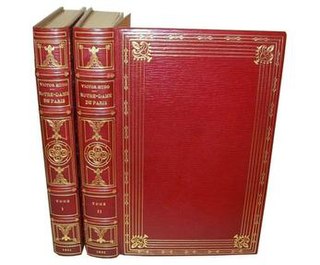
The Hunchback of Notre-Dame is a French Gothic novel by Victor Hugo, published in 1831. The title refers to the Notre-Dame Cathedral, which features prominently throughout the novel. It focuses on the unfortunate story of Quasimodo, the Roma street dancer Esmeralda and Quasimodo's guardian the Archdeacon Claude Frollo in 15th-century Paris. All its elements—the Renaissance setting, impossible love affairs and marginalized characters—make the work a model of the literary themes of Romanticism.

The Hunchback of Notre Dame is a 1996 American animated musical drama film produced by Walt Disney Feature Animation and released by Walt Disney Pictures. It is loosely based on the 1831 novel of the same name by Victor Hugo. The film was directed by Gary Trousdale and Kirk Wise and produced by Don Hahn, from a screenplay written by Tab Murphy, Irene Mecchi, Jonathan Roberts, and the writing team of Bob Tzudiker and Noni White. Featuring the voices of Tom Hulce, Demi Moore, Tony Jay, and Kevin Kline, the film follows Quasimodo, the deformed and confined bell-ringer of Notre Dame, and his yearning to explore the outside world and be accepted by society, against the wishes of his cruel, puritanical foster father Claude Frollo, who also wants to exterminate Paris' Roma population.
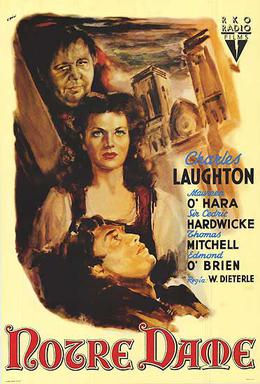
The Hunchback of Notre Dame is a 1939 American romantic drama film starring Charles Laughton and Maureen O'Hara. Directed by William Dieterle and produced by Pandro S. Berman, the film is based on Victor Hugo's 1831 novel. The film is also noted for being the first film ever shown at the Cannes Film Festival before the rest of the festival was cancelled due to the start of World War II.

Quasimodo is a fictional character and the titular character of the novel The Hunchback of Notre-Dame (1831) by Victor Hugo. Quasimodo was born with a hunchback alongside several facial deformities and feared by the townspeople as a sort of monster, but he finds sanctuary in an unlikely love that is fulfilled only in death.
Clopin Trouillefou is a fictional character first created in the 1831 novel The Hunchback of Notre-Dame by French author Victor Hugo, and subsequently adapted.
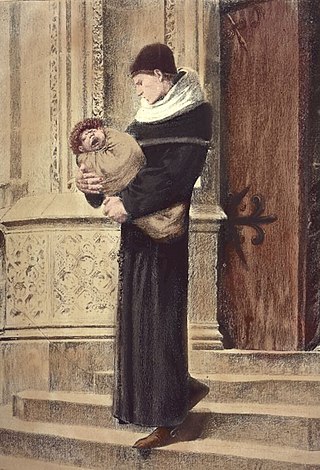
Claude Frollo is a fictional character and the main antagonist of Victor Hugo's 1831 novel The Hunchback of Notre-Dame. He is an alchemist and intellectual, as well as a Catholic clergyman.
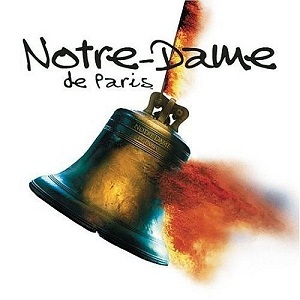
Notre-Dame de Paris is a sung-through French musical which debuted on 16 September 1998 in Paris. It is based upon the novel Notre-Dame de Paris by the French novelist Victor Hugo. The music was composed by Riccardo Cocciante and the lyrics are by Luc Plamondon.

The Hunchback of Notre Dame II is a 2002 American animated musical film directed by Bradley Raymond. It is a direct-to-video sequel to Disney's 1996 animated feature film The Hunchback of Notre Dame. The film was produced by the Japanese office of Walt Disney Animation and Walt Disney Television Animation, while it was distributed by Walt Disney Studios Home Entertainment. Much of the actors from the original film reprise their roles, with the addition of new characters played by Jennifer Love Hewitt, Michael McKean and Haley Joel Osment. Critical reception was mostly negative.
"Hellfire" is a song from Disney's 1996 animated feature The Hunchback of Notre Dame. The song is sung by the film's main antagonist, Judge Claude Frollo, who is voiced by Tony Jay.

Esmeralda, born Agnès, is a fictional character in Victor Hugo's 1831 novel The Hunchback of Notre-Dame. She is a French Roma girl. She constantly attracts men with her seductive dances, and is rarely seen without her clever goat Djali. She is around 16 years old and has a kind and generous heart.

CapitainePhœbus de Châteaupers is a fictional character and the secondary antagonist of Victor Hugo's 1831 novel, Notre-Dame de Paris. He is the Captain of the King Louis XI's Archers. His name comes from Phoebus, the Greek god of the sun.

The Hunchback of Notre Dame is a musical with music and lyrics by Alan Menken and Stephen Schwartz. It is adapted from Walt Disney Animation Studios 1996 film of the same name, which in turn was based on the 1831 novel of the same name by Victor Hugo. The musical premiered in 1999 in Berlin as Der Glöckner von Notre Dame, with a book by James Lapine. It was produced by Disney Theatrical Productions, being the company's first musical to premiere outside the United States. It ran for three years, becoming one of Berlin's longest-running musicals.

Judge Claude Frollo is a fictional character and the main antagonist of Disney's 34th animated film, The Hunchback of Notre Dame (1996). He was based on Archdeacon Claude Frollo from Victor Hugo's 1831 novel.
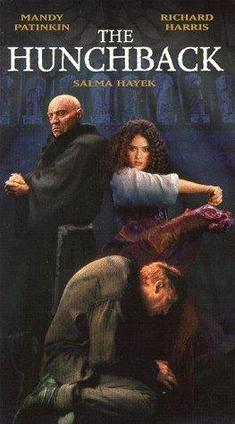
The Hunchback is a 1997 made-for-television romantic drama film based on Victor Hugo's iconic 1831 novel The Hunchback of Notre-Dame, directed by Peter Medak and produced by Stephane Reichel. It stars Richard Harris as Claude Frollo, Salma Hayek as Esmeralda and Mandy Patinkin as Quasimodo, the titular hunchback of Notre Dame. The film premiered on March 16, 1997 on TNT.
The Hunchback of Notre Dame is a British feature length adaptation of the 1831 novel by Victor Hugo, produced for television by the BBC in 1976 and aired on December 30 the same year. Directed by Alan Cooke and written by Robert Muller, the film stars Kenneth Haigh as Claude Frollo, Warren Clarke as Quasimodo and Michelle Newell as Esmeralda, and features the visual effects by Ian Scoones and the original music by Wilfred Josephs.
"The Bells of Notre Dame" is a song from the 1996 Disney film, The Hunchback of Notre Dame, composed by Alan Menken, with lyrics by Stephen Schwartz. It is sung at the beginning of the film by the clown-like gypsy, Clopin. It is set mainly in the key of D minor. The lyrics of the song bear some similarity to the poem The Bells by Edgar Allan Poe, especially the repetition of the word "bells" during the crescendo. The song is reprised at the end of the film.
"God Help the Outcasts" is a song written by composer Alan Menken and lyricist Stephen Schwartz for Walt Disney Pictures' animated film The Hunchback of Notre Dame (1996). A pop ballad, the song is performed by American singer Heidi Mollenhauer as the singing voice of Esmeralda on American actress Demi Moore's behalf, who provides the character's speaking voice. A prayer, "God Help the Outcasts" is a somber hymn in which a beset Esmeralda asks God to shield outcasts and Roma like herself against racism and discrimination at the hands of Paris and Judge Claude Frollo. The song also establishes Esmeralda as a selfless, empathetic character with whom Quasimodo falls in love.
"A Guy Like You" is a song from Disney's 1996 film The Hunchback of Notre Dame. It is performed by the three gargoyles as they try to console Quasimodo. The song was also featured in the German stage musical version, but was replaced with "Flight into Egypt" for the North American stage production.
"Out There" is a song from the 1996 Disney animated film The Hunchback of Notre Dame. Unofficially, it consists of the two songs "Stay In Here" and "Out There". In the stage musical version, Frollo's "Stay In Here" section was expanded into its own song entitled "Sanctuary".
"Topsy Turvy" is a song from Disney's 1996 animated feature The Hunchback of Notre Dame. The song is 5:37 minutes long and is performed by Clopin.











